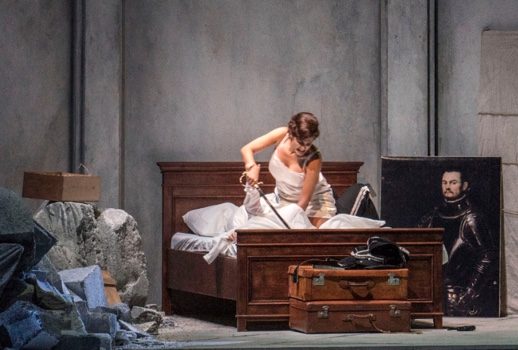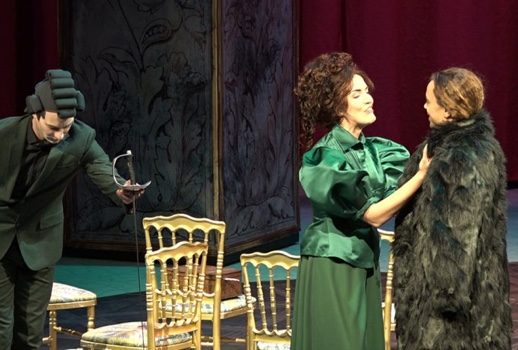
Unfortunately, only half of those have been discovered, and those continue slowly to reach way to reach public awareness, in large part thanks to the tireless efforts of French label Naïve “Vivaldi Edition” to record them with fine singers and conductors.
It is, however, his sole survivor oratorio, Juditha triumphans devicta Holofernis barbarie (Judith triumphant over the barbarians of Holofernes), RV 644, that has enjoyed the most attention, as there are no fewer than 12 recordings out there according to Wikipedia, and in the last five years it has been performed in various places from Venice to London.
I read with excitement that Dutch National Opera announced a new staging of Juditha triumphansby director Floris Visser, who made house debut, under musical direction of Baroque specialist Andrea Marcon with his period-instrument band La Cetra Barockorchester Basel and featuring a young cast, none of them familiar to me before the performance.
Visser detailed his methodology and vision approaching Juditha triumphans; I particularly love the fact that he recognized Juditha triumphansto be a masterpiece, comparable to St Matthew Passion or The Messiah.
httpvh://youtu.be/YGAg5zM1gXE
Historically, Juditha triumphans was commissioned to celebrate the victory of the Venetian (the Christians) over the Turks in August 1716 and it was composed for the girls of the Ospedale della Pietà, an orphanage in Venice internationally renowned for its outstanding music school, where Vivaldi was music director.
In the era of women’s empowerment and #MeToo movement, the message of the story is relevant more than ever, therefore the choice of staging it was completely logical, timely even.
In addition, unlike most oratorios around that time, Juditha triumphans was actually written in conversational style, albeit in Latin (typical for Ospedale), so in a way it lent itself perfectly to staged production.
Visser moved the action to Second World War timeframe, with Holofernes as German Wehrmacht general now, with a penchant for looting precious paintings, including (obviously) Caravaggio’s Judith Beheading Holofernes. What followed was pretty faithful adaptation of the texts in this context, except for the ending.
I liked the fact that he used the painting as a source of inspiration for Judith to kill Holofernes (although, I didn’t enjoy watching her destroying it at the end!)
As for the ending, after Judith beheaded Holofernes, she came into a shock and became deeply distraught with horror even after she was hailed triumphant (the final chorus “Salve invicta Juditha Formosa”).
I thought this was a very sensible reading, considering the situation, although it might exactly not what Vivaldi (or whoever commissioned the piece) had in mind. Nevertheless, his vision for the performance was solid, and he executed it really well.
The handsome set revolved around a remnant of a bombed church, where Holofernes’ men transformed into his residence and place to entertain Judith. That main set was placed on that a revolving turntable, so the actions never stopped.
Dieuweke van Reij, who not only designed the set but also the costumes, apparently set the timeline in winter; therefore everybody on stage was wearing thick overcoats. My only slight reservation was that they were all so impeccably dressed that it almost contradicted the war setting and the ruins surrounding them.
One of the difficulties of mounting Juditha triumphansis that all five of the main characters are pretty much in mezzo-soprano range (with Vagaus being the highest), therefore extra care is needed to ensure they don’t all sound the same (and no, this is a piece that should never be sung by countertenors, in my humble opinion).
Luckily, each of the cast that night differed significantly in both vocal color and characterization.
httpvh://youtu.be/1poekY_MyOk
Dutch National Opera’s website heavily promoted French mezzo-soprano Gaëlle Arquezthat made house debut as Juditha, and she indeed delivered. Arquez is a strikingly beautiful woman with warm, velvety voice; ideal for Juditha. She even looked glamorous in van Reij’s costumes.
I was particularly intrigued with her take on the role. Her Juditha was rather aloof and detached, up to the beheading scene, and from there she looked bewildered (as mentioned above). In the aria “Veni, veni, me sequere fida”, for example, she looked more like a royal consoling a disaster victim rather than a war casualty herself.
I wondered how much of that was specific directional view from Visser; although she did for a while turn sufficiently coy during the seduction scene.
Teresa Iervolino looked and sounded manly as Holofernes, and her voice contrasted well with Arquez. In her hands, Holofernes turned into a complex person, warm and friendly on the surface, with a cold heart inside. Visser really helped in this, particularly with the staging of secret killings of the freedom fighters.
The two supporting roles almost stole the show. Vagaus, with her higher tessitura, tends to always be the showiest, and Vasilisa Berzhanskaya was no exception. Hers was a slimy, manipulative persona, and she showed remarkable agility in the rage aria “Armatae face et anguibus”.
As Juditha’s handmaid Abra, Polly Leech actually demonstrated the widest range of emotions here, from devastation (after the murder of the fighters) to the scary display of satisfaction while singing “Si fulgida per te” and parading Holofernes’ severed head! Her bright timbre also complemented Arquez’s voice efficiently, particularly during the scene heading to the beheading moment.
Lastly, Francesca Ascioti, who also sang the role at the Barbican, sang heroically as the priest-turned-fighter’s leader Ozias.
From my seat in the Orchestra, the beheading action – crucial part of this oratorio – was somewhat obscured by the white fluffy bed sheets; although there were reports of mishaps from previous showings.
If I might nitpick, I wish it were more dramatic, or at least more colorful, as it was staged in a very monochromatic fashion (Juditha was in white satin nightgown, Holofermes in white shirt, plus the white bed sheets).
I was glad to see that Marcon decided to use mixed choir (SATB) for this performance, exactly as written in the score.
There have been recent efforts to transpose the tenor and bass lines up an octave to put them within the normal range of women, most notably as in Alessandro de Marchi’s 2001 Naïve recording (they argued that was done by Vivaldi himself to accommodate the choir of the Pietà). Personally, I felt that using only female voices here resulted the choir lack of “weight”, much needed to balance the soloists.
As expected, the Chorus of Dutch National Opera, led by Klaas-Jan de Groot, performed brilliantly, especially in the opening “Arma, caedes, vindictae, furors” where they descriptively captured the terrors of war.
The biggest asset of the production for me was the transparent conducting of Marcon. The most astonishing aspect of Juditha triumphansis Vivaldi’s unusual and evocative instrumentation, where it seemed that Vivaldi explored the entire arsenal of instruments available at the Pietà during its creation.
For example, for Judith’s arias there is a chalumeau imitating a turtledove‚ a viola d’amore‚ a mandoline and a consort of viola d’inglese to accompany her prayers; and for Holofernes there is a solo oboe. Marcon really highlighted these individual instruments while ensuring that the orchestra supported the singers.

And this was not was not the only Vivaldi opera playing in and around Amsterdam, there was another one touring nearby, Vivaldi – Dangerous Liaisons, a Vivaldi pasticcio.
Merriam-Webster defines pastiche as “a musical, literary, or artistic composition made up of selections from different works; potpourri”. In the 18th century, the practice of opera pastiche was fully embraced by many composers, most probably to supplement their opera seasons.
Handel, for example, had many of these (denoted with prefix “A” in his HWV numberings), including Oreste, Alessandro Severoand Giove in Argo, all of which had been revived in modern times.
There were a number of attempts to create opera pastiches in recent times, most notably the star-studded 2012 production of The Enchanted Island at the Metropolitan Opera. Musical purists tend to dismiss such mountings, arguing that there are many worthy operas still lingering in oblivion, waiting to be revived.
While I can see the arguments, I personally think that every work still needs to be judged purely by its own merits, by the enjoyment that one can get out of it, regardless of the origins.
This show, a collaboration between Opera2Day and The Bach Netherlands Society, painstakingly married Pierre Choderlos de Laclos’ Les Liaisons dangereuseswith Vivaldi’s arias and musical excerpts from his compositions.
This was not the first time such union happened; David Nixon choreographed a ballet version of Dangerous Liaisons to Vivaldi’s music in 1990. There are other opera versions of the story, most notably 1994 SF Opera-commissioned Conrad Susa’s The Dangerous Liaisons and recently, the well-traveled Luca Francesconi’s Quartett.
I used the word “painstaking” above as truly, I think they did one hell of a job creating this pastiche. The libretto, sold separately at the venue, detailed how much work the team had done.
The librettists Stefano Simone Pintor and Serge van Veggel, the latter also directed the performance, reassembled letters from Laclos’ novel and translated them into Italian to create the recitatives for the new opera, working closely with Vanni Moretto who wrote the music.
Vivaldi’s arias were not only reworded, some of them were also re-orchestrated to fit in the story.
httpvh://youtu.be/sxQnXjZENXE
Dangerous Liaisons is set in seven scenes, with the first five forming Part I. The break fell right after Valmont successfully seduced Madame Tourvel.
Afterwards, the evening continued with just two more long scenes. It followed closely the plot of Leclos’ story, only differed at the ending, where Merteuil’s servants, oppressed since the beginning of the opera, revolted against their mistress and destroyed her palace after her letters were found out.
The evening began in a whimsical way, with Merteuil and Valmont getting ready for a party. The set was quite elaborate for such a traveling company, with pillars hanging from the ceiling to decorate Merteuil’s residence. Her servants, all decked in green, ran errands all over the place, including becoming her dinner table at one scene.
In fact, green seemed to be the color of choice here (perhaps symbolizing greed and envy), as the whole stage and costumes were covered with various shades of green from time to time.Mirjam Pater’s costumes were not period-specific, albeit beautiful.
The most exciting scenes in Part I were the seductions of both Cécile and Danceny by Valmont and Merteuil respectively, as they were done in competing pink boudoirs on stage!
After the break, the mood turned somber, although van Veggel tried to shock the audience with the opening scene, where one of Valmont’s servants carried a big cross like Christ on the road to Calvary. Here Vivaldi’s arias and even recitatives dried up, and a big portion of story was now spoken instead.
This was unexpected, and, to be honest, rather disappointing to me, as it felt like the opera was being substituted into a play. Equally intriguing was the shift of focus into social commentary, with Merteuil frequently advising her head of household Victoire, and the “new” ending mentioned above; both of which created a bit of a disconnect with Part I.
The five singers were competent, without anybody truly stood out. Vivaldi’s arias, particularly his aria di bravura, require technical skills and brilliant execution to make the biggest impact, and that was lacking from the quintet, unfortunately.
Candida Guida looked the part and sang earnestly as Merteuil, although she was having some problems with the quick coloratura passages. Countertenor Yosemeh Adje iplayed a carefree Valmont with six-pack abs, but he, too, struggled with his rage arias.
Barbara Kozelj turned into a dramatic Tourvel, while Emma Fekete sounded sufficiently girlish as Cécile. Countertenor Maayan Licht probably sang the best that night, but in my opinion, his voice took some getting used to.
Hernán Schvartzman led the Netherlands Bach Society in a vivid and dynamic reading that truly moved the pace of the opera. He actually also got the biggest cheer of the night. I was actually pleasantly surprised to see that the hall was filled with a lot of teenagers! If this is the way to introduce young audience into a lifetime of opera-goings, I fully support it!
So, the question remained: Was it worth it? Given the efforts to create and perform it, and how it attracted the next generation of opera-goers, I would say: Definitely!




